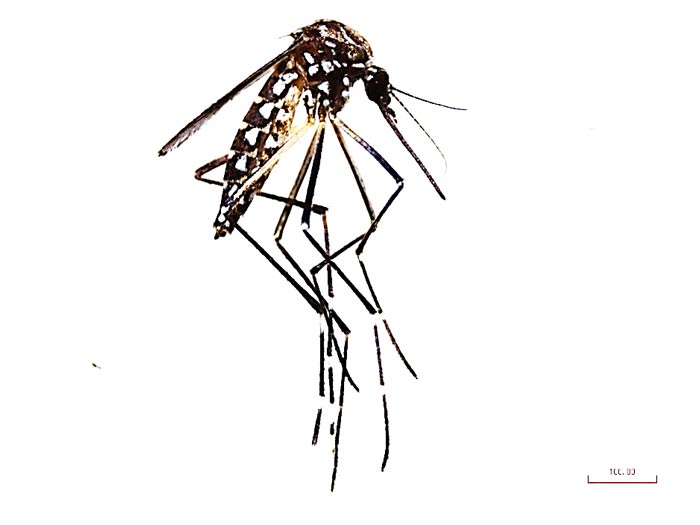New UTEP Insectarium Targets Mosquito-borne Disease Research
Last Updated on October 13, 2017 at 12:00 AM
Originally published October 13, 2017
By Lauren Macias-Cervantes
UTEP Communications
Most of us want mosquitos to go away when we see them, but one group of researchers at The University of Texas at El Paso doesn’t mind them.

Douglas Watts, Ph.D., co-director of infectious disease and immunology for UTEP’s Border Biomedical Research Center, and Camilo Khatchikian, Ph.D., assistant professor of biological sciences, are leading researchers in the College of Science’s new insectary to find out more about mosquitoes, specifically Aedes aegypti.
“The (aedes aegypti) mosquito is very common in El Paso and is of high importance as a public health threat,” Khatchikian said. “It is responsible for the transmission of many viruses, including Zika, dengue fever, yellow fever and chikungunya that have a significant impact on human health … they are in our backyard and because of that, a large portion of the population is exposed to many diseases that these mosquitoes can vector.”
The UTEP insectarium, inside the Biology Building, has been operational for about six months and currently houses mosquitoes in different stages of development.
“It is really about UTEP working to address challenging border health issues through its research,” said College of Science Dean Robert A. Kirken, Ph.D. “Camilo is a unique addition to our team because many scientists work with a virus that comes from the mosquito, but do not work with the mosquito itself. He studies the entire infectious cycle beginning with how a mosquito can acquire and then transmit the virus.”
The insectarium has allowed faculty to implement independent research projects, and it has provided a critically needed support facility for the ongoing surveillance of mosquitoes for arthropod-borne viruses, such as dengue, West Nile and others, and the surveillance of kissing bugs for Trypanosoma cruzi, the parasite that causes Chagas disease.
“This allows for more insight into mosquito human physiology and thus the opportunity to develop new therapeutic strategies to stop the spread of such infectious agents from numerous angles,” Kirken added. “The insectarium allows for other UTEP faculty to consider these models for their own research with this state-of-the-art containment lab to take this type of research to a whole new level.”
The insectary also provides a laboratory that will serve to train undergraduate students who are members of the college’s Mosquito Ecology and Surveillance Laboratory (MESL) under the direction of Cindy Crews.
“The insectary has already provided the capability to maintain colonies of mosquitoes that are critical for supporting my graduate students’ research on the evaluation of Aedes aegypti as a vector of dengue viruses and has provided a source of this mosquito species for collaborative studies with colleagues studying the role of reproductive inhibition as a control strategy for Aedes aegypti,” Watts said.
Pedro Palermo came to UTEP from Peru to study under Watts for his doctoral degree. He has been working on collecting mosquito colonies from different parts of the city and other border communities.
“If we identify that mosquitoes from these border communities can be infected with dengue viruses, there is a possibility that the mosquitoes will spread the disease into El Paso and other border communities,” Palermo explained. The insectary provides an opportunity to study various aspects of the biology and vector role of medically important mosquitoes that can benefit public health locally and globally.
“This facility allows us to do several things with medically important arthropods ” Khatchikian said. “We can rear them and are able to perform experiments related to their adaptation to the environment. We can collect live specimens and bring them to the insectary for identification, collection of genetic material, and test of their responses to various environmental conditions. This is critical to understand where the mosquitoes are coming from and how they are moving within the city to deploy control and mitigation efforts.”
There is no question that the addition of the facility provides an invaluable opportunity for students studying to become researchers, especially to become medical entomologists.
“Pedro could not conduct his research for his Ph.D. without the availability of an insectary because his career interest and goal is to become a molecular virologist with emphasis on mosquito-borne diseases,” Watts explained. “Thus, to achieve his graduate school research goals, he must have the insectary to conduct vector competence studies on Aedes aegypti for dengue viruses, a project that will contribute significantly to the understanding of the potential threat of dengue viruses to human health in the El Paso/Ciudad Juárez community.”
The Biosafety Level 3 laboratory and other Biosafety Level 2 laboratories at UTEP that involve research on vector-borne viral and parasitic diseases are essential to support any research done in the insectary.
“For now the insectary contains mosquitoes in various stages of development and different temperature controlled environments, but in the future other insects may be housed there,” Watts said. “For example, the insectary will provide a safe containment laboratory not only to work safely with live mosquitoes, but also with other medically important arthropods, such as kissing bugs and ticks. It is certain that the insectary will enable UTEP to expand its research programs and offer new opportunities to faculty, staff and students to train and conduct research on medically important arthropods and pathogens that have a significant impact on human health in the border communities.”
The insectarium also enhances the work of the Border Biomedical Research Center, established 25 years ago to lessen the disparity in health status for Hispanics and shed light on issues unique to the border region and its population.
“We hope to work with regional scientists, hospitals, county health officials and the Centers for Disease Control and Prevention on these types of challenging projects that impact the people in the Paso del Norte region,” Kirken said.